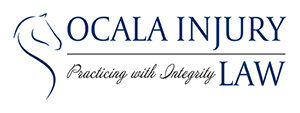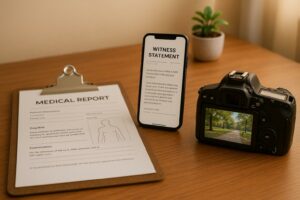If you’ve been injured, a personal injury consultation helps you understand your legal options and the potential value of your case. Most consultations are free and involve reviewing your case details, evidence, and possible strategies with an attorney. Here’s a quick breakdown:
- What Happens: The attorney evaluates your case’s strength, liability, and damages.
- Meeting Formats: Choose in-person, video, or phone consultations based on your needs.
- What to Bring: Medical records, insurance info, incident evidence, and financial documents.
- Key Questions to Ask: Experience, fees, case timelines, and communication practices.
- Cost: Initial consultations are often free; attorneys typically work on contingency fees.
Quick Tip: Act quickly – personal injury claims often have strict filing deadlines. Prepare your documents and consult an attorney as soon as possible to protect your rights.
What Happens in a Personal Injury Consultation?
Basic Elements of a Consultation
A personal injury consultation provides an opportunity for an attorney to examine your case details and decide if your claim has merit. The main goals are to assess the strength of your case and determine if the attorney is the right fit for you.
Attorneys examine cases by analyzing two key areas: liability and damages.
This process helps clarify your legal options and the potential next steps. The structure and length of consultations can vary, as explained below.
Time and Meeting Options
Most consultations take about 30 to 60 minutes. You can choose from different meeting formats, depending on your needs:
| Meeting Format | Benefits | Best For |
|---|---|---|
| In-Person | Face-to-face interaction and document review | Complex cases or severe injuries |
| Video Call | Easy and accessible | Cases involving digital evidence |
| Phone | Flexible and quick | Initial case screenings |
These options allow flexibility based on the complexity of your case and your schedule, ensuring a thorough discussion on all relevant aspects.
Main Discussion Points
During the consultation, the attorney focuses on several key areas to evaluate your case and its potential value:
Incident Details
- Date, time, and location of the event
- Sequence of events leading to the injury
- Witness accounts
- Police reports or other documentation
Medical Information
- The type and severity of your injuries
- Timeline of medical treatments
- Current health condition
- Effects on your daily life and ability to work
Legal Considerations
- Deadlines under the statute of limitations
- Factors affecting liability
- Possible compensation
- Estimated timeline for the case
The attorney also assesses how well you can recount details, reviews any documentation you provide, and may ask for additional evidence if needed.
Getting Ready for Your Consultation
Required Documents
Make sure to gather these key documents before your consultation:
| Document Type | Purpose | Details to Include |
|---|---|---|
| Medical Records | Show the extent of injury | Treatment history, bills, and diagnoses |
| Insurance Information | Confirm coverage | Policy details and claim numbers |
| Incident Evidence | Provide event details | Photos, police reports, and witness info |
| Financial Records | Highlight economic impact | Pay stubs, receipts, and expense records |
| Communication Records | Track interactions | Emails, letters, and text messages |
"When you meet with a personal injury attorney for a consultation, you don’t want to show up empty-handed. You want to give your potential lawyer all the information you can so she can make an accurate evaluation of your injury case." – Brett Snider, Esq.
Once you’ve organized these documents, think about the questions you want to ask during the consultation.
Key Questions for Your Attorney
Asking the right questions will help you evaluate your attorney’s qualifications and approach. Consider these:
Experience and Expertise
- Do they have a track record of handling similar cases?
- What is their history with trials and settlements?
- How do they manage cases and communicate with clients?
Case Assessment
- What is the potential value of your case?
- How long might the process take?
- Are settlements likely, and what strategy will they use?
Practical Matters
- What are their fees, and how are they structured?
- What are their communication protocols?
- Who will handle your case directly?
Having these questions ready ensures you get the clarity you need.
Additional Case Details to Share
Providing thorough details about your case will help the attorney give you a better assessment. Here’s what to discuss:
Incident Information
- The date, time, and location of the event
- A detailed sequence of events
- Contact information for any witnesses
Medical Impact
- Your initial injuries and diagnosis
- The timeline of your treatments
- Your current medical condition and future care needs
Personal Effects
- How the incident has changed your daily life
- Any limitations at work or in daily activities
- Effects on relationships and long-term concerns
These details will help your attorney build a complete picture of your situation and better guide you through the legal process.
Consultation Costs and Fees
Free Initial Consultations
Many personal injury attorneys provide free first consultations. These meetings are designed to evaluate your case and determine if the attorney is a good fit for you, rather than offering detailed legal guidance.
| Consultation Type | Average Cost | What’s Included |
|---|---|---|
| Initial Meeting | $0 | Case evaluation; determining attorney fit |
| Detailed Legal Consultation | $250–$350/hour | In-depth advice and strategy planning |
| Flat-Rate Consultation | $0–$300 | Comprehensive case review |
Payment After Settlement
Most personal injury lawyers work on a contingency fee basis, meaning they get paid only if you win. The typical fee structure is as follows:
-
Before Filing a Lawsuit:
- 33⅓% for settlements up to $1 million
- 30% for compensation between $1 million and $2 million
- 20% for compensation over $2 million
-
After Filing a Lawsuit:
- 40% for settlements up to $1 million
- 30% for compensation between $1 million and $2 million
- 20% for compensation over $2 million
In some cases, additional charges may apply, as detailed below.
Special Fee Situations
Certain scenarios can result in extra costs:
- Appeal Cases: An additional 5% fee may be charged.
- Case-Related Expenses: These include court filing fees, expert witness fees, costs for obtaining medical records, and administrative charges.
These expenses are separate from the attorney’s contingency fee. Most law firms cover these costs upfront and deduct them from your settlement. Be sure to discuss these details during your initial consultation.
sbb-itb-68ed374
Types of Personal Injury Cases
Common Injury Claims
Personal injury law deals with situations where someone’s negligence or intentional actions cause harm. Below are some of the most common cases discussed during legal consultations:
| Type of Case | Annual Frequency | Key Considerations |
|---|---|---|
| Car Accidents | 6+ million cases | Requires timely medical and police reports |
| Dog Bites | 4.5 million incidents | 20% require medical attention |
| Slip and Fall | Common occurrence | Property owner liability |
| Medical Malpractice | Varies by state | Complex proof requirements |
| Workplace Accidents | Significant volume | Workers’ compensation overlap |
"Personal injury law, often referred to as tort law, allows an injured person to seek compensation when someone else’s negligent or intentional act causes harm." – Kevin, Casepacer.com
Knowing these case types can help you understand the key elements needed for a strong claim.
Case Requirements
For a personal injury claim to succeed, it must meet several criteria:
- Proof of Negligence: Evidence that the other party failed to act with reasonable care.
- Direct Causation: A clear connection between the negligent act and your injury.
- Measurable Damages: Documentation of physical, emotional, or financial harm.
- Timely Filing: Compliance with the statutory deadlines for your specific claim.
Keeping detailed records and acting quickly are critical to building a solid case.
Time Limits for Filing
Filing deadlines are an essential part of personal injury cases. Recently, Florida reduced the time limits for certain claims:
| Case Type | Previous Deadline | New Deadline |
|---|---|---|
| Negligence Claims | 4 years | 2 years |
| Medical Malpractice | 2 years | 2 years |
| Wrongful Death | 2 years | 2 years |
"The new tort law in Florida significantly reduces the statute of limitations for personal injury claims from four years to two years. This change emphasizes the importance of acting promptly when seeking legal recourse for injuries." – Todd Miner Law
Claims filed after these deadlines are usually dismissed, no matter how strong the case may be. For incidents occurring before March 24, 2023, the previous four-year limit still applies.
Steps in a Consultation Meeting
Meeting Structure
A typical consultation lasts between 30 and 60 minutes and includes the following phases:
| Phase | Tasks |
|---|---|
| Initial Discussion | Overview of the case and description of the incident |
| Document Review | Review of medical records and supporting evidence |
| Legal Assessment | Case evaluation and strategy discussion |
| Q&A Session | Addressing questions and outlining next steps |
Working with Your Attorney
Once the meeting structure is clear, the focus shifts to how your attorney evaluates your case. This process involves examining the evidence and understanding the full extent of your injuries. Make sure to provide detailed and accurate information.
Key elements include:
- Incident Details: A clear and accurate timeline of the event that caused your injury.
- Medical Documentation: Information on current treatments and any anticipated future medical needs.
- Evidence Review: Supporting materials such as photos, witness statements, and other relevant records.
Legal Options and Next Steps
After the assessment, your attorney will discuss the potential legal path forward. This conversation typically includes:
- Case Timeline: An outline of how long the process may take and any key deadlines.
- Compensation Potential: An initial estimate of possible damages.
- Legal Strategy: The proposed approach to handling your case.
- Required Documentation: Any additional evidence or records that may be needed to strengthen your case.
Selecting a Personal Injury Attorney
After your consultation, it’s important to carefully evaluate an attorney’s background, service practices, and ability to earn your trust. This ensures you’re making the right choice for your legal representation.
Attorney Background Check
Look into the attorney’s qualifications and experience by checking the following:
- Legal Education: Confirm their state bar admission and any relevant specialization certifications.
- Case Experience: Review their history with cases similar to yours.
- Professional Standing: Check for any disciplinary actions or peer reviews.
- Client Feedback: Read online reviews and testimonials from past clients.
Client Service Standards
Make sure the attorney’s communication and service practices meet your expectations. Key things to look for include:
- Timely responses to calls and emails, ideally within 24–48 hours.
- Regular updates on your case’s progress.
- Direct access to the attorney, not just their support staff.
- Clear, written explanations of legal processes and agreements.
Building Client Trust
Trust is earned through transparency and understanding, which should be evident during your consultation. Pay attention to:
- Honest evaluations of your case, highlighting both strengths and challenges.
- A clear fee structure, including upfront discussions about contingency fees and other costs.
- An empathetic attitude that shows they genuinely care about your situation.
- Well-organized operations that reflect professionalism and reliability.
Your initial consultation is your chance to gauge these qualities. Notice if the attorney listens carefully to your story and offers realistic expectations for your case.
Next Steps After Reading
Now that you understand the consultation process, take action right away after an injury to protect your rights and potential compensation.
Key Documents to Collect:
- Police and incident reports
- Photos or videos of the accident and injuries
- Medical records and bills
- Insurance details
- Witness statements
- Employment and financial records
What to Do Immediately:
Contact a personal injury attorney as soon as possible. Fort Lauderdale injury lawyer Jarrett Blakeley emphasizes:
"If you have plans to claim compensation for personal injury, it is important to seek treatment as soon as possible. The insurance company could object to your claims on the basis that you did not visit the doctor immediately. It can also be difficult to prove the injuries were a result of the car accident if you wait too long."
Steps to Strengthen Your Claim:
- Write down accident details while they’re fresh in your mind.
- Document your recovery process.
- Avoid discussing your case on social media.
- Stick to your medical appointments and treatment plan.
- Save all receipts and records related to the accident.
Taking these steps early can help build a stronger case before reaching out for legal support. When you’re ready, contact Alida "Ali" Catherine Darias and her team for a free consultation, available 24/7 by phone, virtually, or in person – whether at your home, hospital room, or their offices in The Villages and Ocala.




